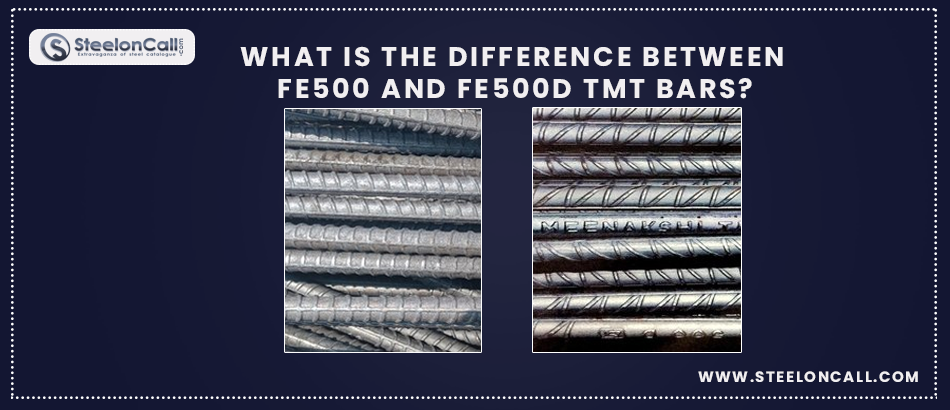Difference between Fe500 and Fe500D TMT bars

Fe 500 TMT steel rods are utilized for structures in India. The "Fe" represents iron, that is used in the assembling of TMT bars, while 500 represents the most extreme yield stresses it can hold up under. TMT bars, for the most part, accompany various grades like Fe-450, Fee-450d, Fe-500, Fe-500d, Fe-550, Fe-550d, and Fe-600, which refer to the quality and strengths of the bars. Fe 500 and Fe 500d bars are highly used for the construction process, which gives high resistance to the construction process. More top the grade, the more prominent the qualities and less utilization of iron. Each grade bar is utilized for various purposes. Both the fe500 and fe500d bars have the same rigidity; however, the distinction lies in their flexible element. Greater flexibility implies more prolongation ability and consequently guarantees a long life cycle for the constructions. The elongation capacity of the fe500 is increased by 12%, whereas for Fe-500d is 18%. This Fe 500 d and Fe 500 steel determination bars are created under carefully managed fabricating processes, which makes them effectively bendable. There is a significant association between cement and steel. Concrete has extraordinary compressive power yet generally low elasticity and flexibility; in this manner, when it wires with TMT steel bars, it offers to ascend to a profoundly pliable and plastic blend.
Fe 500 and Fe 500d have an equivalent 0.2% stress/yield stress, whereas the tensile strength is increased by 2%. The base elasticity for Fe 500 is 545 mpa, and for Fe 500d, it is 565 mpa. Fe 500d has upgraded the least rate elongation, which is equal to 18%, whereas Fe 500 has a value of 12%. From the chemical composition point, Fe 500d has 0.25% carbon of most extreme when contrasted with 0.30% (max) in Fe 500. Likewise, the most extreme levels of sulfur and phosphorus are lower in Fe 500d. Fe 500d with smaller amounts of carbon, sulfur, and phosphorus helps preserve the steel and opposes seismic tremor stuns in the future. Both fe500 and fe500d TMT bars should offer at least 500 mpa of yield quality, where they differ, however, is the flexibility parameter. Fe500d evaluation of TMT rebar offers higher flexibility than the Fe 500 rebar. Pliability is necessary for the presentation of rebar inside a structure, particularly during extraordinary stacking conditions.
Fe500d represents high flexibility TMT steel bars, which is the best option for use in developments in seismic zones as malleability and stun opposition give durability in an occasion of a tremor. The symbol' stands for flexibility. From the perspective of mechanical properties, the fe500d grade TMT bar has better flexibility as looked at than the fe500 grade. Fe 500d high flexibility is the fundamental element for which it is generally utilized in all construction purposes. Fragile material can't trade higher vitality. Though, fee 500d for high pliability can assimilate abrupt burdens during catastrophic events, such as quakes, floods, and so forth. Fe 500d is the most favored TMT rebar in high seismic zones in the wake of dissolving the wipe iron and liquid metal in a shoot heater in 500d TMT rebar; it is a standard strategy to dephosphorylate the steel in the spoon by following the metallurgical procedure. Minimization of utilizing the piece brings command over tramp components like Cu,v, ni,cr, and so forth. Fe-500d additionally has more security highlights contrasted with Fe-500. It even expends less carbon, phosphorus, and sulfur rate, settling on them the right decision for withstanding catastrophic events like seismic tremors, violent winds, and torrents. Fe-500 has 0.30% carbon through Fe 500d has quite recently 0.25%.
Chemical structure decides the best prolongation in TMT rebar. The 500/fe 500d level of TMT bars contains a lower level of sulfur & phosphorus, which makes these bars exceptionally worthy for a wide range of construction purposes. Fe 500 is a top pick among engineers who construct and configuration structures with numerous floors, and fe500 is the default decision of TMT bars with regards to underground structures, such as storm cellar floors and wells. From the concoction creation point, fe500d has 0.25% carbon (max) when contrasted with 0.30% (max) in fe500. Additionally, the most extreme level of sulfur and phosphorus are lower in fe500d. The basic difference between the two grades of steel and from these perceptions we can without much of a stretch express the Fe 500d grade TMT steel is preferred to perform over Fe 500. It improves 500d steel as a result of its higher protection from excessively seismic exercises like tremors and its lower levels of carbon guarantee simpler and better weldability.
In SteelOnCall, we offer both Fe 500 and Fe 500d grades with the best prices.

